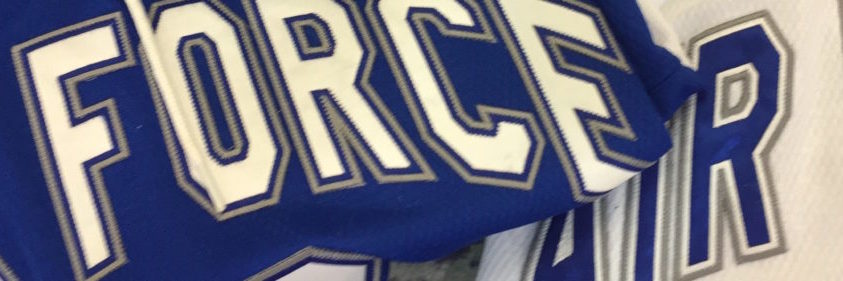With those factors in mind, here’s a look at how last season’s freshmen fared. Players are listed in alphabetical order:
Erich Jaeger
After playing in two games in the first two months, Jaeger filled in admirably when injuries started to mount for the Falcons. He played in six games in a row in December and early January then five more in a row from late January into February, when he tallied two of his three points. He was a plus player (+4), rarely committed penalties and played well when called upon.
 Pierce Pluemer
Pierce Pluemer
The tallest Falcon (6-foot-4) also acquitted himself well when called upon, getting six points in 29 games while battling some nagging second-half injuries. He had a three-point game in a key AHC matchup at Robert Morris in January and was a plus player (+2). One encouraging aspect of his play was his ability to get shots on net; he averaged almost two per game (1.8), which put him in the top 10 on the team despite fewer offensive starts than most, if not all, of the players above him on that list. His potential to contribute more is immense.
Matt Pulver
Pulver was considered the marquee freshman coming into last season, several teammates have told me, but unfortunately his campaign ended after eight games because of a shoulder injury that eventually required surgery. Despite a limited sample size, he impressed, picking up a goal and an assist in little more than seven games and being a plus player. Another accurate shooter (12.5 percent), he could take a big leap statistically if he plays a majority of the games. I’m told he is fully recovered.
 Trevor Stone
Trevor Stone
Stone was in and out of the lineup in the first half of the season, but played in 13 consecutive games in the second half, when he got seven of his 12 points (second most among Falcons freshmen). In between he had a two-goal game at Merrimack on Jan. 6. Stone has a hard and accurate shot, particularly in close, according to Falcons goalie Billy Christopoulos. Stone’s six goals came on 40 shots (15 percent accuracy).
Brady Tomlak
Tomlak was a revelation, playing in 38 games and finishing tied for ninth in scoring on a deep Falcons group with 18 points. The center also was statistically the Falcons’ top dog on draws, winning 57.3 percent of his face-offs (on 410 chances, fourth most on the team behind Tyler Ledford, Kyle Haak and Evan Feno). And, Tomlak brings an element of size down the middle of the ice. At 6-foot-2, 200 pounds, he is 2 to 5 inches taller than the other three centers and at least 15 pounds heavier. In addition, Tomlak was one of the more accurate shooters, burying 5 of his 26 shots on goal (19.2 percent). Only Jordan Himley had a better rate. He was a road warrior, too, scoring 15 of his 18 points away from Cadet Arena. All three times he had multiple points in a game (Nov. 12 at RIT, Jan. 20 at Robert Morris and Feb. 3 at Bentley) the Falcons won.
 Joe Tyran
Joe Tyran
A torn ACL sustained in the exhibition game last season wiped out his freshman season, but make no mistake, had he been healthy he was in the mix to get some playing time. And it will be important that he gains some experience this season with four of the top six defensemen being seniors. He also is fully healthy heading into this season.
Final analysis
It was a battle for this group to earn playing time last season, and major injuries knocked out two of the six for most (Pulver) or all (Tryan) of the campaign. Others also got dinged up at times. The same playing time challenges will be there this season because the senior and junior classes are so deep and skilled, but don’t be surprised to see some from this group in the lineup regularly and others spotted throughout the season. This group’s individual and collective upside belies their modest statistics, and they give the Falcons enviable depth at positions that already were strong.
Go inside the numbers on Air Force’s seniors here
Go inside the numbers on Air Force’s juniors here
Follow @AFAFlightPath on Twitter to get updates on Air Force hockey





